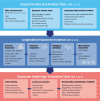Advancing tools for human early lifecourse exposome research and translation (ATHLETE): Project overview
- PMID: 34934888
- PMCID: PMC8683140
- DOI: 10.1097/EE9.0000000000000166
Advancing tools for human early lifecourse exposome research and translation (ATHLETE): Project overview
Abstract
Early life stages are vulnerable to environmental hazards and present important windows of opportunity for lifelong disease prevention. This makes early life a relevant starting point for exposome studies. The Advancing Tools for Human Early Lifecourse Exposome Research and Translation (ATHLETE) project aims to develop a toolbox of exposome tools and a Europe-wide exposome cohort that will be used to systematically quantify the effects of a wide range of community- and individual-level environmental risk factors on mental, cardiometabolic, and respiratory health outcomes and associated biological pathways, longitudinally from early pregnancy through to adolescence. Exposome tool and data development include as follows: (1) a findable, accessible, interoperable, reusable (FAIR) data infrastructure for early life exposome cohort data, including 16 prospective birth cohorts in 11 European countries; (2) targeted and nontargeted approaches to measure a wide range of environmental exposures (urban, chemical, physical, behavioral, social); (3) advanced statistical and toxicological strategies to analyze complex multidimensional exposome data; (4) estimation of associations between the exposome and early organ development, health trajectories, and biological (metagenomic, metabolomic, epigenetic, aging, and stress) pathways; (5) intervention strategies to improve early life urban and chemical exposomes, co-produced with local communities; and (6) child health impacts and associated costs related to the exposome. Data, tools, and results will be assembled in an openly accessible toolbox, which will provide great opportunities for researchers, policymakers, and other stakeholders, beyond the duration of the project. ATHLETE's results will help to better understand and prevent health damage from environmental exposures and their mixtures from the earliest parts of the life course onward.
Keywords: Adolescent health; Child health; Early life; Exposome; Exposure assessment.
Copyright © 2021 The Authors. Published by Wolters Kluwer Health, Inc. on behalf of The Environmental Epidemiology. All rights reserved.
Conflict of interest statement
The authors declare that they have no conflicts of interest with regard to the content of this report.
Figures



References
-
- Kuh D; New Dynamics of Ageing (NDA) Preparatory Network. A life course approach to healthy aging, frailty, and capability. J Gerontol A Biol Sci Med Sci. 2007;62:717–721. - PubMed
-
- Blane D, Kelly-Irving M, D’Errico A, Bartley M, Montgomery S. Social-biological transitions: how does the social become biological? Longitud Life Course Stud Int J. 2013;3:136–146.
-
- Godfrey KM, Gluckman PD, Hanson MA. Developmental origins of metabolic disease: life course and intergenerational perspectives. Trends Endocrinol Metab. 2010;21:199–205. - PubMed
-
- Durmuş B, Heppe DH, Taal HR, et al. . Parental smoking during pregnancy and total and abdominal fat distribution in school-age children: the Generation R Study. Int J Obes (Lond). 2014;38:966–972. - PubMed
-
- Taal HR, de Jonge LL, van Osch-Gevers L, et al. . Parental smoking during pregnancy and cardiovascular structures and function in childhood: the Generation R Study. Int J Epidemiol. 2013;42:1371–1380. - PubMed
Publication types
Grants and funding
LinkOut - more resources
Full Text Sources
